| Revision as of 12:46, 25 January 2005 editInstantnood (talk | contribs)32,683 editsNo edit summary← Previous edit | Latest revision as of 13:57, 11 January 2025 edit undoNotAG on AWB (talk | contribs)Confirmed users1,720 editsm →top: per TfD, replaced: {{IPA-yue → {{IPA|yueTag: AWB | ||
| Line 1: | Line 1: | ||
| {{short description|Public square in Beijing, China}} | |||
| '''Tian'anmen Square''' (天安门广场; Traditional: 天安門廣場; ]: Tiān'ānmén Guǎngchǎng) is a large paved public plaza near the middle of ], ] in front of the ], facing ]. ''Tian'anmen'' means "]", which is located north of the Square. The square is best known worldwide for the ]. | |||
| {{About|the city square|the historical event|1989 Tiananmen Square protests and massacre}} | |||
| {{pp-pc|small=yes}} | |||
| <!--Do not add the ''Tank Man'' image by Jeff Widener (AP) to this article as a decision was made that it can only be used in the Tank Man article. See ]--> | |||
| {{Infobox Chinese | |||
| | title = Tiananmen Square | |||
| | pic = Tian'anmen from the square (20200825114150).jpg | |||
| | picsize = 275px | |||
| | piccap = Tiananmen Square in 2020 | |||
| | pictooltip = Groups of people wander around Tiananmen Square in the late afternoon. The eponymous Tiananmen, literally "Gate of Heavenly Peace", sits in the background. | |||
| | mnc = ᡝᠯᡥᡝ ᠣᠪᡠᡵᡝ ᡩᡠᡴᠠ | |||
| | mnc_rom = elhe obure duka | |||
| | s = {{linktext|天安门广场}} | |||
| | t = {{linktext|天安門廣場}} | |||
| | p = Tiān'ānmén Guǎngchǎng | |||
| | gr = Tian'anmen Goangchaang | |||
| | bpmf = ㄊㄧㄢ ㄢ ㄇㄣˊ<br />ㄍㄨㄤˇ ㄔㄤˇ | |||
| | w = {{tone superscript|Tʻien1-an1-mên2 Kuang3-chʻang3}} | |||
| | mi = {{IPA|cmn|tʰjɛ́n.án.mə̌n kwǎŋ<!--tone sandhi-->.tʂʰàŋ|}} | |||
| | lmz = Thie-oe-men Kuaon-zan | |||
| | poj = Thian-an-mn̂g Kóng-tiûⁿ | |||
| | y = Tīn'ōnmùhn Gwóngchèuhng | |||
| | j = {{tone superscript|Tin1on1mun4 Gwong2coeng4}} | |||
| | ci = {{IPA|yue|tʰíːn.ʔɔ́ːn.mȕːn kʷɔ̌ːŋ.tsʰœ̏ːŋ|}} | |||
| | order = st | |||
| | showflag = p | |||
| }} | |||
| '''Tiananmen Square''' or '''Tian'anmen Square''' ({{IPAc-en|ˈ|t|j|ɛ|n|ə|n|m|ə|n}}<ref>{{Cite dictionary |url=http://www.lexico.com/definition/Tiananmen_Square |archive-url=https://web.archive.org/web/20210518063701/https://www.lexico.com/definition/tiananmen_square |url-status=dead |archive-date=May 18, 2021 |title=Tiananmen Square |dictionary=] UK English Dictionary |publisher=]}}</ref>) is a ] in the ] of ], ], named after the ] ("''Gate of Heavenly Peace''") located to its north, which separates it from the ]. The square contains the ], the ], the ], and the ]. ] ] the founding of the People's Republic of China in the square on October 1, 1949; the anniversary of this event is still observed there.<ref>The Columbia Encyclopedia, 6th ed</ref> The size of Tiananmen Square is 765 x 282 meters (215,730 m<sup>2</sup> or 53.31 acres).<ref>{{cite web |title=Tiananmen Square incident|url=https://www.britannica.com/event/Tiananmen-Square-incident |website=Britannica |access-date=11 February 2021}}</ref> It has great cultural significance as it was the site of several ] in Chinese history. | |||
| Outside China, the square is best known for the ] that ended with a ] due to international media coverage, internet and global connectivity, its political implications, and other factors.<ref name="bbc-right">{{cite news |url=http://news.bbc.co.uk/1/hi/8057762.stm |date=2 June 2009 |title=Tiananmen killings: Were the media right? |first=James |last=Miles |access-date=3 November 2010 |work=BBC News }}</ref><ref name="bbc">{{cite news |url=https://www.bbc.com/news/world-asia-china-42465516 |date=23 December 2017 |title=Tiananmen Square protest death toll 'was 10,000'|access-date=3 June 2019 |work=BBC News }}</ref><ref>{{Cite web |date=2009-06-04 |title=The Truth Behind The Tiananmen Square Massacre - CBS News |url=https://www.cbsnews.com/news/there-was-no-tiananmen-square-massacre/ |access-date=2023-06-30 |website=www.cbsnews.com |language=en-US}}</ref> Within China, there is a ] of knowledge of the crackdowns by the ].<ref>{{Cite web |last1=Ruan |first1=Lotus |last2=Knockel |first2=Jeffrey |last3=Ng |first3=Jason Q. |last4=Crete-Nishihata |first4=Masashi |date=December 2016 |title=One App, Two Systems |url=https://citizenlab.ca/2016/11/wechat-china-censorship-one-app-two-systems |url-status=live |archive-url=https://web.archive.org/web/20191010221114/https://citizenlab.ca/2016/11/wechat-china-censorship-one-app-two-systems/ |archive-date=10 October 2019 |access-date=30 September 2019 |at=figure 9}}</ref> | |||
| ] | |||
| ==History== | |||
| Built in ], the square is 880 metres south to north and 500 metres east to west. In 1651 (early ]), the gate was renovated and renamed to its present form. During the ] and ] eras, there was no public square at Tiananmen, and instead the area was filled with offices for imperial ministries. These were badly damaged during the ] and the area was cleared to produce the beginning of Tiananmen Square. | |||
| ===Early history=== | |||
| ], viewed from Zhengyangmen Gate (Qianmen Gate) with the Gate of China, later removed in 1954 to make room for the present-day ]. The "corridor of a thousand steps" is visible (behind the Gate of China) and Tiananmen Gate is in the distance.]] | |||
| ] in 1919]] | |||
| ] | |||
| The ] ("Gate of Heavenly Peace"), a gate in the wall of the ], was built in 1417 during the ]. During the 17th century, fighting between ]'s rebel forces and the forces of the ]-led ] caused heavy damage to, or even destroyed, the gate. Tiananmen Square was designed and built in 1651 and was enlarged fourfold in the 1950s.<ref name="autogenerated1">Safra, J. (Ed.). (2003). Tiananmen Square. In New ], The (15th ed., Chicago: Vol. 11). Encyclopædia Britannica INC. p. 752. </ref><ref>{{cite web|url=http://encyclopedia2.tfd.com/Tiananmen+Square|title=Tiananmen Square|publisher=Britannica Concise Encyclopedia. 2007|access-date=2008-08-03}}</ref> | |||
| The gate historically known as the "Great Ming Gate", the southern gate to the Imperial City stands near the center of the square. It was renamed the "Great Qing Gate" during the Qing dynasty, and the "]" during the ]. Unlike the other gates in Beijing, such as the Tiananmen and the ], this was a purely ceremonial gateway, with three arches but no ramparts, similar in style to the ceremonial gateways found in the ]. This gate had a special status as the "Gate of the Nation", as can be seen from its successive names. It normally remained closed, except when the ] passed through. Commoner traffic was diverted to side gates at the western and eastern ends of the square, respectively. Because of this diversion in traffic, a busy marketplace, called "Chess Grid Streets", was developed in the large fenced square to the south of this gate.{{Cn|date=August 2023}} | |||
| Enlarged in ] to 100 acres (400,000 m²), its flatness is broken only by the 38-metre-high ] and ] mausoleum. It is lit with huge lamposts which also sport video cameras. The ] is on the western side of the Square. Qiánmén (Front Gate) is on the south side of the Square. National Museum of Chinese History is on the east side of the Square. Changan Avenue, which is used for parades, lies between Tiananmen Gate and the Square. Much part of the Square is open space with no trees or benches. Trees line the east and west edges of the Square. It is heavily monitored by uniformed and plainclothes policemen. | |||
| ===19th century=== | |||
| Tiananmen Square has been the site of a number of political events such as the proclamation of the ] by ] in October 1, 1949 and for mass rallies during the ]. It has also been the site of a number of protest movements, most notably the ] of ] for ] and ], ] after the death of ], and the ]. | |||
| In 1860, during the ], when British and French troops occupied Beijing, they pitched camp near the gate and briefly considered burning down the gate and the Forbidden City. Ultimately, they decided to spare the Forbidden City and instead burn down the ]. The ] eventually agreed to let ] barrack troops – and later establish diplomatic missions – in the area, hence there was the ] immediately to the east of the square. When the forces of the ] besieged Beijing during the ] in 1900, they badly damaged the office complexes and burnt down several ministries. After the Boxer Rebellion ended, the area became a space for the Eight-Nation Alliance to assemble their military forces.{{Cn|date=August 2023}} | |||
| ===20th century=== | |||
| The protests of 1989 resulted in the killing of several thousand young Chinese in the square and adjacent areas and is thus called the ]. | |||
| In Beijing, Tiananmen was re-developed from an insular imperial quarter to a larger public space viewed as consistent socialist political.<ref name=":Curtis&Klaus">{{Cite book |last1=Curtis |first1=Simon |title=The Belt and Road City: Geopolitics, Urbanization, and China's Search for a New International Order |last2=Klaus |first2=Ian |publisher=] |isbn=9780300266900 |location=New Haven and London |publication-date=2024 |doi=10.2307/jj.11589102 |jstor=jj.11589102}}</ref>{{Rp|page=110}} Over the 1950s, the square was quadrupled in size.<ref name=":Curtis&Klaus" />{{Rp|page=110}} | |||
| In 1954, the ] was demolished to allow for the enlargement of the square. In November 1958, a major expansion of Tiananmen Square started, which was completed after only 11 months, in August 1959. This followed the vision of ] to make the square the largest and most spectacular in the world and intended to hold over 500,000 people. In that process, a large number of residential buildings and other structures were demolished.<ref name="Li 2007">Li, M. Lilliam; Dray-Novey, Alison J.; Kong, Haili (2007) ''Beijing: From Imperial Capital to Olympic City'', Palgrave, {{ISBN|978-1-4039-6473-1}}</ref> On its southern edge, the ] has been erected. Concomitantly, as part of the ] constructed between 1958 and 1959 to commemorate the ten-year anniversary of the People's Republic of China (PRC), the ] and the Revolutionary History Museum (now the ]) were erected on the western and eastern sides of the square.<ref name="Li 2007" /> | |||
| ==Images from near and in the square== | |||
| For the first decade of the PRC, each ] (October 1) was marked by a large military parade in Tiananmen Square, in conscious emulation of the annual Soviet celebrations of the Bolshevik Revolution. After the disaster of the Great Leap Forward, the CCP decided to cut costs and have only smaller annual National Day celebrations in addition to a large celebration with a military parade every 10 years. However, the chaos of the Cultural Revolution almost prevented such an event from taking place on National Day in 1969 but did take place in 1966 and 1970.{{Cn|date=August 2023}} | |||
| ] | |||
| ] | |||
| ] of ]]] | |||
| ] | |||
| ] and the ]]] | |||
| ] to the ] with reviewing stands in front]] | |||
| In 1971, large portraits of ], ], ], ], ], and Mao Zedong were erected in the square, painted by artist ], who is also responsible for producing the famous portrait of Mao that hangs over the Gate of Heavenly Peace. In 1980, with the downgrading of political ideology following Mao's death, the portraits were taken down and thenceforth only brought out on Labor Day (May 1) and National Day.{{Cn|date=August 2023}} | |||
| <br style="clear:both;" /> | |||
| Ten years later, in 1979, the CCP again decided against a large-scale celebration, coming at a time when Deng Xiaoping was still consolidating power and China had suffered a rebuff in a border war with Vietnam early in the year. By 1984, with the situation much improved and stabilized, the PRC held a military parade for the first time since 1959. The aftermath of the Tiananmen Square massacre prevented any such activities in October 1989, but military parades have been held in 1999 and 2009, on the 50th and 60th anniversaries of the PRC's founding.<ref>{{Cite web |title=1999 Tiananmen Square |url=https://www.chinadaily.com.cn/60th/2009-08/27/content_8623814.htm |archive-url=}}</ref> | |||
| == External link == | |||
| * | |||
| * | |||
| One year after Mao's death, a ] was built near the site of the former Gate of China along the main north–south axis of the square. In connection with this project, the square was further increased in size to become fully rectangular and being able to accommodate 600,000 people.<ref name="Li 2007"/> | |||
| ] | |||
| ] | |||
| ] | |||
| ] | |||
| ] | |||
| ] | |||
| ] | |||
| ====1989 protests and massacre==== | |||
| ] | |||
| {{Main|1989 Tiananmen Square protests and massacre}} | |||
| ] | |||
| In 1989, Tiananmen Square was the site of the 1989 Tiananmen Square protests that culminated in violence and a crackdown by the ].<ref>, BBC, 23 December 2021</ref><ref>{{Cite news |date=2009-06-02 |title=Tiananmen killings: Were the media right? |language=en-GB |work=BBC |url=http://news.bbc.co.uk/2/hi/asia-pacific/8057762.stm |access-date=2023-06-29}}</ref> Following the crackdown, many of the student leaders escaped to the United States with the help of foreign intelligence agencies and other parties through ]. <ref>{{Cite web |date=2019-05-31 |title=The lives of Tiananmen's most wanted, 30 years on |url=https://qz.com/1618805/the-1989-tiananmen-student-leaders-on-chinas-most-wanted-list |access-date=2023-06-29 |website=Quartz |language=en}}</ref> | |||
| The urban context of the square was altered in the 1990s with the construction of ] in its vicinity and the expansion of the National Museum.<ref name="Li 2007"/> | |||
| ==Configuration== | |||
| ] | |||
| Used as a venue for mass gatherings since its creation, its flatness is contrasted by both the 38-meter (125 ft)-high "Monument to the People's Heroes" and the "Mausoleum of Mao Zedong".<ref name="autogenerated1" /> The square lies between two ancient, massive gates: the Tiananmen to the north and the Zhengyangmen, known as ], to the south. Along the west side of the square is the Great Hall of the People. Along the east side is the National Museum of China dedicated to Chinese history predating 1919. | |||
| Erected in 1989, Liberty, a statue representing the western icon previously held her torch over the square.<ref>{{Cite book|last=Roberts|first=John Morris|chapter-url=https://archive.org/details/historyofworld0001robe/page/912|title=History of the world|chapter=The Chinese Enigma|date=1993|page=912|publisher=Oxford University Press|isbn=0-19-521043-3|location=New York|oclc=28378422}}</ref> | |||
| ==Visits== | |||
| Since Dec 15, 2021, visitors must make a reservation before entering the square area.<ref>{{Cite web |date=2021-11-24 |title=Visit to Tiananmen Square Will be by Reservation Only from December 15 |url=http://english.beijing.gov.cn/latest/news/202111/t20211124_2543664.html |access-date=2023-08-08 |website=english.beijing.gov.cn |language=en-US}}</ref> | |||
| ==Events== | |||
| {{See also|1976 Tiananmen Incident|1989 Tiananmen Square protests and massacre|Flag Raising Ceremony|May Fourth Movement}} | |||
| ] | |||
| Tiananmen Square has been the site of a number of notable political events, student protests, and armed conflict. | |||
| Among the most notable events that have occurred on Tiananmen Square were protests during the ] in 1919, the proclamation of the People's Republic of China by ] on October 1, 1949, the ] after the death of ], and the ] after the death of ], which was suppressed in a military crackdown.<ref>{{cite book|last=Wong|first=Jan|title=Red China Blues|year=1997|publisher=Random House|page=278}}</ref> Shortly after the crackdown, a man, dubbed ], was photographed obstructing a column of tanks on Chang'an Avenue near the square. | |||
| Other notable events included annual mass military displays on each anniversary of the 1949 proclamation until October 1, 1959; the 1984 ] for the ] which coincided with the ascendancy of ]; military displays and parades on the ] in 1999; the ] in 2001; military displays and parades on the 60th anniversary of the People's Republic of China in 2009, and ]. In 2023, police detained over 20 people, including Activist ], on the 34th anniversary of the bloody Tiananmen Square crackdown for "breaching the peace".<ref>{{Cite news |date=2023-06-04 |title=Hong Kong police arrest pro-democracy figures on Tiananmen Square anniversary |language=en-GB |work=The Guardian |url=https://www.theguardian.com/world/2023/jun/04/hong-kong-police-arrest-pro-democracy-activist-alexandra-wong-on-tiananmen-square-anniversary |access-date=2023-06-07}}</ref> | |||
| ==Panorama== | |||
| <imagemap> | |||
| Image:200401-beijing-tianan-square-overview.jpg|thumb|800px|center|Panorama ] of Tiananmen Square from the north atop ]'s gate tower, showing the square beyond ], the ] and ] (background center), the ] (on the left), and ] (on the right) (''mouse over for labels'') | |||
| poly 148 187 471 188 472 219 267 247 150 241 ] | |||
| poly 1048 242 1097 238 1168 266 990 278 653 293 412 291 201 270 184 267 261 250 500 259 675 260 933 258 1042 247 1082 245 ] | |||
| poly 680 181 684 178 689 181 691 215 707 217 715 221 658 226 664 219 682 217 ] | |||
| poly 1136 237 1186 263 1278 250 1273 231 ] | |||
| poly 11 235 32 230 259 250 192 264 ] | |||
| poly 658 224 664 216 681 216 681 179 693 179 692 216 705 216 715 223 727 223 726 185 694 178 672 178 650 191 647 202 ] | |||
| poly 905 178 904 211 1113 235 1252 226 1253 191 1235 190 1236 164 1114 152 ] | |||
| poly 1237 180 1236 191 1253 191 1253 226 1277 224 1278 188 ] | |||
| poly 344 249 652 260 924 249 1038 242 821 218 730 227 645 226 627 222 561 226 538 225 298 249 ] | |||
| poly 299 252 330 255 331 306 302 305 299 309 ] | |||
| poly 959 249 998 247 1002 309 965 313 ] | |||
| poly 1 265 277 373 554 408 905 394 1277 301 1277 427 701 427 435 427 2 426 ] | |||
| desc top-left | |||
| </imagemap> | |||
| ==Gallery== | |||
| <gallery widths="220" heights="185"> | |||
| File:TiananmenGatePic1.jpg|] gate to the north of Tiananmen Square | |||
| File:NationalMuseumofChinapic1.jpg|] on the east side of the square | |||
| File:GreatHallofthePeoplepic2.jpg|The ] on the west side of the square | |||
| File:BeijingTiananmenSquaregatepicture2.jpg|] Gate Tower marking the south end of Tiananmen Square | |||
| File:Monument people's heroes 2.jpg|] and the ] occupy the center of the square | |||
| File:Monument to the People's Heroes.jpg|] | |||
| File:Mausoleum von Mao Zedong.jpg|] | |||
| File:Tianamen Square-Monument.jpg|Monument in front of Mao's Mausoleum on Tiananmen Square | |||
| File:Kaiguodadian.jpg|Students attending the founding ceremony of the People's Republic of China on October 1, 1949. | |||
| File:HammerSickle Tiananmen.jpg|A temporary monument in Tiananmen Square marking the 90th anniversary of the ] in 2011 | |||
| File:National mourning for 2008 Sichuan earthquake victims - Tiananmen Square, Beijing, 2008-05-19.jpg|National mourning on May 19, 2008, for the victims of the ] | |||
| File:November 29 student demonstration, Tiananmen Square.jpg|Students gather for a demonstration in Tiananmen Square, {{Circa|1917}}–1919. | |||
| </gallery> | |||
| == References == | |||
| {{Reflist}} | |||
| ==External links== | |||
| {{Wiktionary|Tiananmen Square|Tian'anmen Square|Tian An Men Square|Tienanmen Square}} | |||
| *Photo of young people at May Day Parade, 1957 | |||
| *Photo of May Day Parade, 1957 | |||
| *Photo of May Day Parade, 1957 | |||
| {{Portal|China}} | |||
| * {{Commons category-inline|Tiananmen Square}} | |||
| {{Dongcheng District, Beijing}} | |||
| {{Censorship in China}} | |||
| {{authority control}} | |||
| {{Coord|39|54|12|N|116|23|30|E|type:landmark|display=title}} | |||
| ] | |||
| ] | |||
| ] | |||
| ] | |||
| ] | |||
| ] | |||
| ] | |||
| ] | |||
Latest revision as of 13:57, 11 January 2025
Public square in Beijing, China This article is about the city square. For the historical event, see 1989 Tiananmen Square protests and massacre.
| Tiananmen Square | |||||||||||||||||||||||||||||||
|---|---|---|---|---|---|---|---|---|---|---|---|---|---|---|---|---|---|---|---|---|---|---|---|---|---|---|---|---|---|---|---|
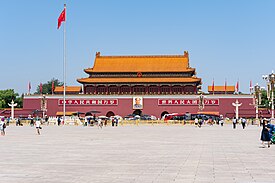 Tiananmen Square in 2020 Tiananmen Square in 2020 | |||||||||||||||||||||||||||||||
| Chinese name | |||||||||||||||||||||||||||||||
| Simplified Chinese | 天安门广场 | ||||||||||||||||||||||||||||||
| Traditional Chinese | 天安門廣場 | ||||||||||||||||||||||||||||||
| Hanyu Pinyin | Tiān'ānmén Guǎngchǎng | ||||||||||||||||||||||||||||||
| |||||||||||||||||||||||||||||||
| Manchu name | |||||||||||||||||||||||||||||||
| Manchu script | ᡝᠯᡥᡝ ᠣᠪᡠᡵᡝ ᡩᡠᡴᠠ | ||||||||||||||||||||||||||||||
| Romanization | elhe obure duka | ||||||||||||||||||||||||||||||
Tiananmen Square or Tian'anmen Square (/ˈtjɛnənmən/) is a city square in the city center of Beijing, China, named after the Tiananmen ("Gate of Heavenly Peace") located to its north, which separates it from the Forbidden City. The square contains the Monument to the People's Heroes, the Great Hall of the People, the National Museum of China, and the Mausoleum of Mao Zedong. Mao Zedong proclaimed the founding of the People's Republic of China in the square on October 1, 1949; the anniversary of this event is still observed there. The size of Tiananmen Square is 765 x 282 meters (215,730 m or 53.31 acres). It has great cultural significance as it was the site of several important events in Chinese history.
Outside China, the square is best known for the 1989 protests and massacre that ended with a military crackdown due to international media coverage, internet and global connectivity, its political implications, and other factors. Within China, there is a strict censorship of knowledge of the crackdowns by the Chinese Communist Party.
History
Early history
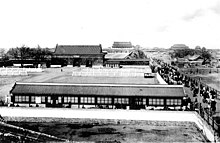

The Tiananmen ("Gate of Heavenly Peace"), a gate in the wall of the Imperial City, was built in 1417 during the Ming dynasty. During the 17th century, fighting between Li Zicheng's rebel forces and the forces of the Manchu-led Qing dynasty caused heavy damage to, or even destroyed, the gate. Tiananmen Square was designed and built in 1651 and was enlarged fourfold in the 1950s.
The gate historically known as the "Great Ming Gate", the southern gate to the Imperial City stands near the center of the square. It was renamed the "Great Qing Gate" during the Qing dynasty, and the "Gate of China" during the Republican era. Unlike the other gates in Beijing, such as the Tiananmen and the Zhengyang Gate, this was a purely ceremonial gateway, with three arches but no ramparts, similar in style to the ceremonial gateways found in the Ming tombs. This gate had a special status as the "Gate of the Nation", as can be seen from its successive names. It normally remained closed, except when the emperor passed through. Commoner traffic was diverted to side gates at the western and eastern ends of the square, respectively. Because of this diversion in traffic, a busy marketplace, called "Chess Grid Streets", was developed in the large fenced square to the south of this gate.
19th century
In 1860, during the Second Opium War, when British and French troops occupied Beijing, they pitched camp near the gate and briefly considered burning down the gate and the Forbidden City. Ultimately, they decided to spare the Forbidden City and instead burn down the Old Summer Palace. The Xianfeng Emperor eventually agreed to let Western powers barrack troops – and later establish diplomatic missions – in the area, hence there was the Legation Quarter immediately to the east of the square. When the forces of the Eight-Nation Alliance besieged Beijing during the Boxer Rebellion in 1900, they badly damaged the office complexes and burnt down several ministries. After the Boxer Rebellion ended, the area became a space for the Eight-Nation Alliance to assemble their military forces.
20th century
In Beijing, Tiananmen was re-developed from an insular imperial quarter to a larger public space viewed as consistent socialist political. Over the 1950s, the square was quadrupled in size.
In 1954, the Gate of China was demolished to allow for the enlargement of the square. In November 1958, a major expansion of Tiananmen Square started, which was completed after only 11 months, in August 1959. This followed the vision of Mao Zedong to make the square the largest and most spectacular in the world and intended to hold over 500,000 people. In that process, a large number of residential buildings and other structures were demolished. On its southern edge, the Monument to the People's Heroes has been erected. Concomitantly, as part of the Ten Great Buildings constructed between 1958 and 1959 to commemorate the ten-year anniversary of the People's Republic of China (PRC), the Great Hall of the People and the Revolutionary History Museum (now the National Museum of China) were erected on the western and eastern sides of the square.
For the first decade of the PRC, each National Day (October 1) was marked by a large military parade in Tiananmen Square, in conscious emulation of the annual Soviet celebrations of the Bolshevik Revolution. After the disaster of the Great Leap Forward, the CCP decided to cut costs and have only smaller annual National Day celebrations in addition to a large celebration with a military parade every 10 years. However, the chaos of the Cultural Revolution almost prevented such an event from taking place on National Day in 1969 but did take place in 1966 and 1970.
In 1971, large portraits of Karl Marx, Friedrich Engels, Vladimir Lenin, Joseph Stalin, Sun Yat-sen, and Mao Zedong were erected in the square, painted by artist Ge Xiaoguang, who is also responsible for producing the famous portrait of Mao that hangs over the Gate of Heavenly Peace. In 1980, with the downgrading of political ideology following Mao's death, the portraits were taken down and thenceforth only brought out on Labor Day (May 1) and National Day.
Ten years later, in 1979, the CCP again decided against a large-scale celebration, coming at a time when Deng Xiaoping was still consolidating power and China had suffered a rebuff in a border war with Vietnam early in the year. By 1984, with the situation much improved and stabilized, the PRC held a military parade for the first time since 1959. The aftermath of the Tiananmen Square massacre prevented any such activities in October 1989, but military parades have been held in 1999 and 2009, on the 50th and 60th anniversaries of the PRC's founding.
One year after Mao's death, a mausoleum was built near the site of the former Gate of China along the main north–south axis of the square. In connection with this project, the square was further increased in size to become fully rectangular and being able to accommodate 600,000 people.
1989 protests and massacre
Main article: 1989 Tiananmen Square protests and massacreIn 1989, Tiananmen Square was the site of the 1989 Tiananmen Square protests that culminated in violence and a crackdown by the People's Liberation Army. Following the crackdown, many of the student leaders escaped to the United States with the help of foreign intelligence agencies and other parties through Operation Yellowbird.
The urban context of the square was altered in the 1990s with the construction of National Grand Theater in its vicinity and the expansion of the National Museum.
Configuration
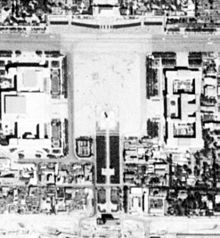
Used as a venue for mass gatherings since its creation, its flatness is contrasted by both the 38-meter (125 ft)-high "Monument to the People's Heroes" and the "Mausoleum of Mao Zedong". The square lies between two ancient, massive gates: the Tiananmen to the north and the Zhengyangmen, known as Qianmen, to the south. Along the west side of the square is the Great Hall of the People. Along the east side is the National Museum of China dedicated to Chinese history predating 1919.
Erected in 1989, Liberty, a statue representing the western icon previously held her torch over the square.
Visits
Since Dec 15, 2021, visitors must make a reservation before entering the square area.
Events
See also: 1976 Tiananmen Incident, 1989 Tiananmen Square protests and massacre, Flag Raising Ceremony, and May Fourth Movement
Tiananmen Square has been the site of a number of notable political events, student protests, and armed conflict.
Among the most notable events that have occurred on Tiananmen Square were protests during the May Fourth Movement in 1919, the proclamation of the People's Republic of China by Mao Zedong on October 1, 1949, the Tiananmen Square protests in 1976 after the death of Zhou Enlai, and the 1989 Tiananmen Square protests and massacre after the death of Hu Yaobang, which was suppressed in a military crackdown. Shortly after the crackdown, a man, dubbed Tank Man, was photographed obstructing a column of tanks on Chang'an Avenue near the square.
Other notable events included annual mass military displays on each anniversary of the 1949 proclamation until October 1, 1959; the 1984 military parade for the 35th anniversary of the People's Republic of China which coincided with the ascendancy of Deng Xiaoping; military displays and parades on the 50th anniversary of the People's Republic of China in 1999; the Tiananmen Square self-immolation incident in 2001; military displays and parades on the 60th anniversary of the People's Republic of China in 2009, and a terror attack in 2013 involving a vehicle that plowed into pedestrians. In 2023, police detained over 20 people, including Activist Alexandra Wong, on the 34th anniversary of the bloody Tiananmen Square crackdown for "breaching the peace".
Panorama
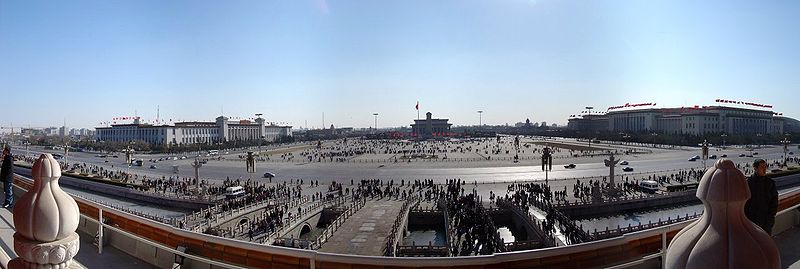
Gallery
-
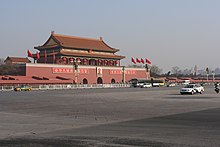 Tiananmen gate to the north of Tiananmen Square
Tiananmen gate to the north of Tiananmen Square
-
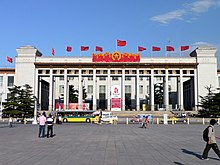 National Museum of China on the east side of the square
National Museum of China on the east side of the square
-
 The Great Hall of the People on the west side of the square
The Great Hall of the People on the west side of the square
-
 Zhengyangmen Gate Tower marking the south end of Tiananmen Square
Zhengyangmen Gate Tower marking the south end of Tiananmen Square
-
 Monument to the People's Heroes and the Mausoleum of Mao Zedong occupy the center of the square
Monument to the People's Heroes and the Mausoleum of Mao Zedong occupy the center of the square
-
 Monument to the People's Heroes
Monument to the People's Heroes
-
 Mausoleum of Mao Zedong
Mausoleum of Mao Zedong
-
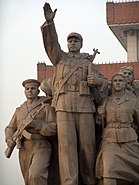 Monument in front of Mao's Mausoleum on Tiananmen Square
Monument in front of Mao's Mausoleum on Tiananmen Square
-
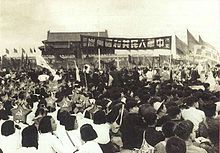 Students attending the founding ceremony of the People's Republic of China on October 1, 1949.
Students attending the founding ceremony of the People's Republic of China on October 1, 1949.
-
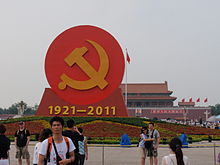 A temporary monument in Tiananmen Square marking the 90th anniversary of the Chinese Communist Party in 2011
A temporary monument in Tiananmen Square marking the 90th anniversary of the Chinese Communist Party in 2011
-
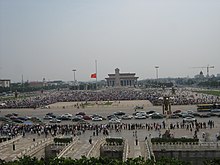 National mourning on May 19, 2008, for the victims of the 2008 Sichuan earthquake
National mourning on May 19, 2008, for the victims of the 2008 Sichuan earthquake
-
 Students gather for a demonstration in Tiananmen Square, c. 1917–1919.
Students gather for a demonstration in Tiananmen Square, c. 1917–1919.
References
- "Tiananmen Square". Lexico UK English Dictionary. Oxford University Press. Archived from the original on May 18, 2021.
- The Columbia Encyclopedia, 6th ed
- "Tiananmen Square incident". Britannica. Retrieved 11 February 2021.
- Miles, James (2 June 2009). "Tiananmen killings: Were the media right?". BBC News. Retrieved 3 November 2010.
- "Tiananmen Square protest death toll 'was 10,000'". BBC News. 23 December 2017. Retrieved 3 June 2019.
- "The Truth Behind The Tiananmen Square Massacre - CBS News". www.cbsnews.com. 2009-06-04. Retrieved 2023-06-30.
- Ruan, Lotus; Knockel, Jeffrey; Ng, Jason Q.; Crete-Nishihata, Masashi (December 2016). "One App, Two Systems". figure 9. Archived from the original on 10 October 2019. Retrieved 30 September 2019.
- ^ Safra, J. (Ed.). (2003). Tiananmen Square. In New Encyclopædia Britannica, The (15th ed., Chicago: Vol. 11). Encyclopædia Britannica INC. p. 752. Britannica Online version
- "Tiananmen Square". Britannica Concise Encyclopedia. 2007. Retrieved 2008-08-03.
- ^ Curtis, Simon; Klaus, Ian (2024). The Belt and Road City: Geopolitics, Urbanization, and China's Search for a New International Order. New Haven and London: Yale University Press. doi:10.2307/jj.11589102. ISBN 9780300266900. JSTOR jj.11589102.
- ^ Li, M. Lilliam; Dray-Novey, Alison J.; Kong, Haili (2007) Beijing: From Imperial Capital to Olympic City, Palgrave, ISBN 978-1-4039-6473-1
- "1999 Tiananmen Square".
- "Tiananmen Square: What happened in the protests of 1989", BBC, 23 December 2021
- "Tiananmen killings: Were the media right?". BBC. 2009-06-02. Retrieved 2023-06-29.
- "The lives of Tiananmen's most wanted, 30 years on". Quartz. 2019-05-31. Retrieved 2023-06-29.
- Roberts, John Morris (1993). "The Chinese Enigma". History of the world. New York: Oxford University Press. p. 912. ISBN 0-19-521043-3. OCLC 28378422.
- "Visit to Tiananmen Square Will be by Reservation Only from December 15". english.beijing.gov.cn. 2021-11-24. Retrieved 2023-08-08.
- Wong, Jan (1997). Red China Blues. Random House. p. 278.
- "Hong Kong police arrest pro-democracy figures on Tiananmen Square anniversary". The Guardian. 2023-06-04. Retrieved 2023-06-07.
External links
- Photo of young people at May Day Parade, 1957
- Photo of May Day Parade, 1957
- Photo of May Day Parade, 1957
 Media related to Tiananmen Square at Wikimedia Commons
Media related to Tiananmen Square at Wikimedia Commons
39°54′12″N 116°23′30″E / 39.90333°N 116.39167°E / 39.90333; 116.39167
Categories: